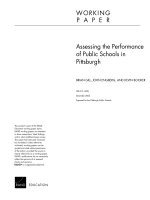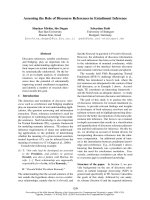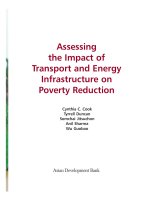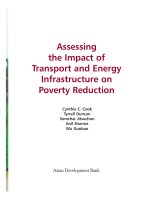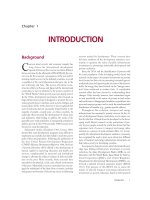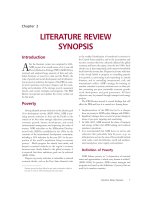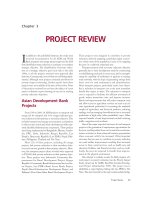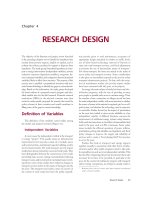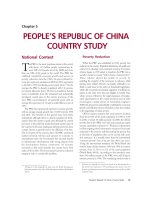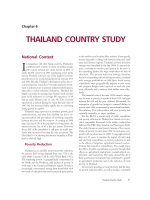ASSESSING the ACCURACY of REMOTELY SENSED DATA - CHAPTER 2 pptx
Bạn đang xem bản rút gọn của tài liệu. Xem và tải ngay bản đầy đủ của tài liệu tại đây (704.66 KB, 4 trang )
©1999 by CRC Press
CHAPTER
2
Overview
The history of remote sensing is a relatively short one. Aerial photography has
been used as a mapping tool effectively for just over half a century. Digital image
scanners and cameras on satellites and airplanes have even a shorter history spanning
a little over 2 decades. However, it was the development of these digital devices that
had the most profound impact on accuracy assessment for all remotely sensed data.
AERIAL PHOTOGRAPHY
The first aerial photograph was acquired from a balloon in 1858, but it wasn’t
until 1909 that Wilbur Wright took the first aerial photograph from an airplane. Even
then the extensive use of aerial photography for mapping and interpreting land use
and land cover didn’t begin until after World War II (Spurr 1948). In these early
days, the focus was primarily on the development of new cameras and other instru-
ments to make the best use of the aerial photographs. Spurr, in his excellent book
entitled Aerial Photographs in Forestry (1948), presents the prevailing opinion about
assessing the accuracy of photo interpretation. He states, “Once the map has been
prepared from the photographs, it must be checked on the ground. If preliminary
reconnaissance has been carried out, and a map prepared carefully from good quality
photographs, ground checking may be confined to those stands whose classification
could not be agreed upon in the office, and to those stands passed through en route
to these doubtful stands.” In other words, a qualitative visual check to see if the map
looks right has traditionally been recommended.
Finally, in the 1950s some researchers saw the need for quantitative assessment
of photo interpretation in order to promote their discipline as a science (Sammi
1950, Katz 1952, Young 1955, Colwell 1955). In a panel discussion entitled, “Reli-
ability of Measured Values” held at the 18th Annual Meeting of the American Society
of Photogrammetry, Mr. Amrom Katz (1952), the panel chair, made a very compel-
ling plea for the use of statistics in photogrammetry. Other panel discussions were
held and talks were presented that culminated with a paper by Young and Stoeckler
(1956). In this paper they actually propose techniques for a quantitative evaluation
L986ch02.fm Page 7 Monday, May 21, 2001 1:21 PM
©1999 by CRC Press
of photo interpretation, including the use of an error matrix to compare field and
photo classifications, and a discussion of the boundary error problem.
Unfortunately, these techniques never received widespread attention nor accep-
tance. The Manual of Photo Interpretation published by the American Society of
Photogrammetry (1960) does mention the need to train and test photo interpreters.
However, it contains no description of the quantitative techniques proposed by a
brave few in the 1950s. Nor will the reader find a textbook today on photo inter-
pretation that deals with these techniques.
It seems that photo interpretation has become a time-honored skill, and the
prevailing opinion is that a quantitative assessment is unnecessary. In speaking with
some of the old-time photo interpreters, they remember those times when quantitative
assessment was an issue. In fact, they mostly agree with the need to perform such
an assessment and are usually the first to point out the limitations of photo inter-
pretation.
And so the quantitative assessment of photo interpretation has never become a
requirement of any project. Rather, the assumption that the map was correct or at
least good enough prevailed. Then along came digital remote sensing, and some of
these fundamental assumptions about photo interpretation were shaken.
DIGITAL ASSESSMENTS
As in the early days of aerial photography, the launch of Landsat 1 in 1972
resulted in a great burst of exuberant effort as researchers and scientists charged
ahead trying to develop the field of digital remote sensing. In those early days, much
progress was made and there wasn’t much time to sit back and evaluate how they
were doing. After approximately 5 years into the Landsat program, researchers began
to consider and realistically evaluate where they were going and to some extent how
they were doing with respect to quality.
The history of accuracy assessment of remotely sensed data is relatively short,
beginning around 1975. Researchers, notably Hord and Brooner (1976), van Gen-
deren and Lock (1977), and Ginevan (1979), proposed criteria and techniques for
testing map accuracy. In the early 1980s more in-depth studies were conducted and
new techniques proposed (Rosenfield et al., 1982; Congalton et al., 1983; and
Aronoff, 1985). Finally, from the late 1980s up to the present time, a great deal of
work has been conducted on accuracy assessment. More and more researchers,
scientists, and users are discovering the need to adequately assess the results of
remotely sensed data.
The history of digital accuracy assessment can be effectively divided into four
parts or epochs. Initially, no real accuracy assessment was performed, but rather an
“it looks good” mentality prevailed. This approach is typical of a new, emerging
technology in which everything is changing so quickly that there is not time to sit
back and assess how well you are doing. Despite the maturing of the technology
over the last 15 years, some remote sensing analysts are still stuck in this mentality.
The second epoch is called the age of non-site specific assessment. During this
period, overall acreages were compared between ground estimates and the map
L986ch02.fm Page 8 Monday, May 21, 2001 11:34 AM
©1999 by CRC Press
without regard for location. The second epoch was relatively short-lived and quickly
led to the age of site specific assessments.
In a site specific assessment, actual places on the ground are compared to the
same place on the map and a measure of overall accuracy (i.e., percent correct)
presented. Site specific assessment techniques were the dominant method until the
late 1980s.
Finally, the fourth and current age of accuracy assessment could be called the
age of the error matrix. An error matrix compares information from reference sites
to information on the map for a number of sample areas. The matrix is a square
array of numbers set out in rows and columns that express the labels of samples
assigned to a particular category in one classification relative to the labels of samples
assigned to a particular category in another classification (Figure 2-1). One of the
classifications, usually the columns, is assumed to be correct and is termed the
reference data. The rows usually are used to display the map labels or classified
data generated from the remotely sensed data. Thus, two labels from each sample
are compared to one another:
• Reference data labels: the class label of the accuracy assessment site derived from
data collected that is assumed to be correct; and
• Classified data or map labels: the class label of the accuracy assessment site derived
from the map.
Error matrices are very effective representations of map accuracy, because the
individual accuracies of each map category are plainly described along with both
the errors of inclusion (commission errors) and errors of exclusion (omission errors)
Figure 2-1 Example error matrix.
L986ch02.fm Page 9 Monday, May 21, 2001 11:34 AM
©1999 by CRC Press
present in the map. A commission error occurs when an area is included in an
incorrect category. An omission error occurs when an area is excluded from the
category to which it belongs.
In addition to clearly showing errors of omission and commission, the error
matrix can be used to compute overall accuracy, producer’s accuracy, and user’s
accuracy (Story and Congalton 1986). Overall accuracy is simply the sum of the
major diagonal (i.e., the correctly classified pixels or samples) divided by the total
number of pixels or samples in the error matrix. This value is the most commonly
reported accuracy assessment statistic. Producer’s and user’s accuracies are ways of
representing individual category accuracies instead of just the overall classification
accuracy (see Chapter 5 for more details on the error matrix).
Proper use of the error matrix includes correctly sampling the map and rigorously
analyzing the matrix results. The techniques and considerations of the building and
analyzing of an error matrix are the main themes of this book.
L986ch02.fm Page 10 Monday, May 21, 2001 11:34 AM
